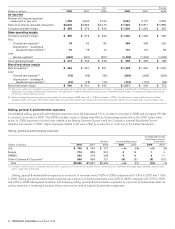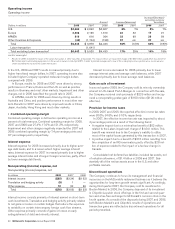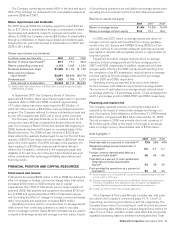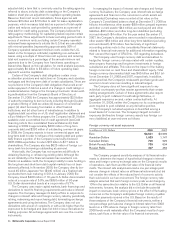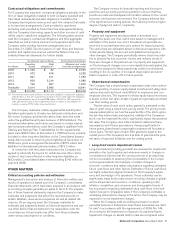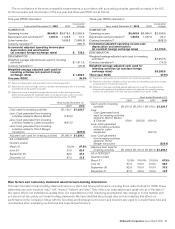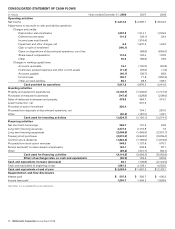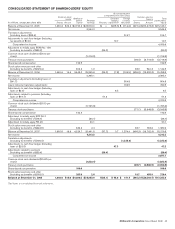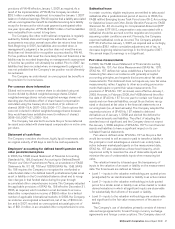McDonalds 2008 Annual Report Download - page 39
Download and view the complete annual report
Please find page 39 of the 2008 McDonalds annual report below. You can navigate through the pages in the report by either clicking on the pages listed below, or by using the keyword search tool below to find specific information within the annual report.
Contractual obligations and commitments
The Company has long-term contractual obligations primarily in the
form of lease obligations (related to both Company-operated and
franchised restaurants) and debt obligations. In addition, the
Company has long-term revenue and cash flow streams that relate
to its franchise arrangements. Cash provided by operations
(including cash provided by these franchise arrangements) along
with the Company’s borrowing capacity and other sources of cash
will be used to satisfy the obligations. The following table summa-
rizes the Company’s contractual obligations and their aggregate
maturities as well as future minimum rent payments due to the
Company under existing franchise arrangements as of
December 31, 2008. See discussions of cash flows and financial
position and capital resources as well as the Notes to the con-
solidated financial statements for further details.
Contractual cash outflows Contractual cash inflows
In millions Operating
leases Debt
obligations(1) Minimum rent under
franchise arrangements
2009 $ 1,046 $ 32 $ 2,090
2010 972 616 2,028
2011 891 611 1,952
2012 809 2,214 1,886
2013 746 657 1,809
Thereafter 5,614 5,980 13,641
Total $10,078 $10,110 $23,406
(1) The maturities reflect reclassifications of short-term obligations to long-term obligations
of $1.3 billion, as they are supported by a long-term line of credit agreement expiring in
2012. Debt obligations do not include $108 million of SFAS No. 133 noncash fair
value adjustments because these adjustments have no impact on the obligation at
maturity, as well as $174 million of accrued interest.
The Company maintains certain supplemental benefit plans
that allow participants to (i) make tax-deferred contributions and
(ii) receive Company-provided allocations that cannot be made
under the qualified benefit plans because of IRS limitations. The
investment alternatives and returns are based on certain market-
rate investment alternatives under the Company’s qualified Profit
Sharing and Savings Plan. Total liabilities for the supplemental
plans were $390 million at December 31, 2008 and were primarily
included in other long-term liabilities on the Consolidated balance
sheet. Also included in other long-term liabilities at December 31,
2008 were gross unrecognized tax benefits of $272 million and
liabilities for international retirement plans of $131 million.
In connection with the Latam transaction, the Company has
agreed to indemnify the buyers for certain tax and other claims,
certain of which are reflected in other long-term liabilities on
McDonald’s Consolidated balance sheet totaling $142 million at
year-end 2008.
OTHER MATTERS
Critical accounting policies and estimates
Management’s discussion and analysis of financial condition and
results of operations is based upon the Company’s consolidated
financial statements, which have been prepared in accordance with
accounting principles generally accepted in the U.S. The prepara-
tion of these financial statements requires the Company to make
estimates and judgments that affect the reported amounts of
assets, liabilities, revenues and expenses as well as related dis-
closures. On an ongoing basis, the Company evaluates its
estimates and judgments based on historical experience and vari-
ous other factors that are believed to be reasonable under the
circumstances. Actual results may differ from these estimates
under various assumptions or conditions.
The Company reviews its financial reporting and disclosure
practices and accounting policies quarterly to ensure that they
provide accurate and transparent information relative to the current
economic and business environment. The Company believes that
of its significant accounting policies, the following involve a higher
degree of judgment and/or complexity:
• Property and equipment
Property and equipment are depreciated or amortized on a
straight-line basis over their useful lives based on management’s
estimates of the period over which the assets will generate rev-
enue (not to exceed lease term plus options for leased property).
The useful lives are estimated based on historical experience with
similar assets, taking into account anticipated technological or
other changes. The Company periodically reviews these lives rela-
tive to physical factors, economic factors and industry trends. If
there are changes in the planned use of property and equipment,
or if technological changes occur more rapidly than anticipated, the
useful lives assigned to these assets may need to be shortened,
resulting in the recognition of increased depreciation and amor-
tization expense or write-offs in future periods.
• Share-based compensation
The Company has a share-based compensation plan which author-
izes the granting of various equity-based incentives including stock
options and restricted stock units (RSUs) to employees and non-
employee directors. The expense for these equity-based incentives
is based on their fair value at date of grant and generally amortized
over their vesting period.
The fair value of each stock option granted is estimated on the
date of grant using a closed-form pricing model. The pricing model
requires assumptions, such as the expected life of the stock option,
the risk-free interest rate and expected volatility of the Company’s
stock over the expected life, which significantly impact the assumed
fair value. The Company uses historical data to determine these
assumptions and if these assumptions change significantly for
future grants, share-based compensation expense will fluctuate in
future years. The fair value of each RSU granted is equal to the
market price of the Company’s stock at date of grant less the pres-
ent value of expected dividends over the vesting period.
• Long-lived assets impairment review
Long-lived assets (including goodwill) are reviewed for impairment
annually in the fourth quarter and whenever events or changes in
circumstances indicate that the carrying amount of an asset may
not be recoverable. In assessing the recoverability of the Compa-
ny’s long-lived assets, the Company considers changes in
economic conditions and makes assumptions regarding estimated
future cash flows and other factors. Estimates of future cash flows
are highly subjective judgments based on the Company’s experi-
ence and knowledge of its operations. These estimates can be
significantly impacted by many factors including changes in global
and local business and economic conditions, operating costs,
inflation, competition, and consumer and demographic trends. A
key assumption impacting estimated future cash flows is the esti-
mated change in comparable sales. If the Company’s estimates or
underlying assumptions change in the future, the Company may be
required to record impairment charges.
When the Company sells an existing business to a devel-
opmental licensee, it determines when these businesses are “held
for sale” in accordance with the requirements of SFAS No. 144,
Accounting for the Impairment or Disposal of Long-lived Assets.
Impairment charges on assets held for sale are recognized when
McDonald’s Corporation Annual Report 2008 37





